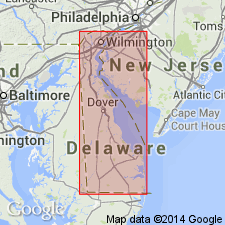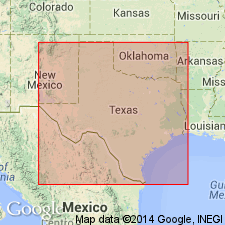
- Usage in publication:
-
- Ramsey sand
- Modifications:
-
- First used
- Dominant lithology:
-
- Sandstone
- AAPG geologic province:
-
- Permian basin
Summary:
Designated Ramsey sand (informal, unranked) within the upper part of the Bell Canyon formation of the Delaware Mountain group. Occurs in subsurface of the northern Delaware basin [in Permian basin], in northwest Reeves, Loving, and northeast Culberson Counties, Texas, and in southern Eddy and Lea Counties, New Mexico. Name Ramsey sand replaces term "first sand" of local usage. Is a producing interval that is relatively discontinuous and of variable thickness (0 to 70 feet) owing to preservation in paleotopographic lows. Generally consists of gray, fine-grained, relatively clean, massive, friable sand. In places, may contain a small (4 feet thick), low permeable silty sand or calcareous streak dividing the Ramsey approximately in half. Very fine- to medium-grained reservoir sands are arkosic containing minor clastic carbonate grains and 10 to 20 percent carbonate cement. Is interpreted to have been deposited by shallow submarine density currents. Where present, underlies Trap subdivision (new, informal) and overlies Ford siltstone (new, informal), both of Bell Canyon formation. Age is Permian (Guadalupian). Report includes generalized structure contour map.
Type gamma ray-sonic log presented but not located. Origin of name not stated by author.
Source: Modified from GNU records (USGS DDS-6; Denver GNULEX).

- Usage in publication:
-
- Ramsey sandstone member
- Modifications:
-
- Revised
- Overview
- AAPG geologic province:
-
- Permian basin
Summary:
Redescribed from Ramsey sand (unranked, informal) to Ramsey sandstone member (informal). Is part of the upper Bell Canyon Formation of the Delaware Mountain Group, in Delaware basin area [in Permian basin], southwest Texas and southeast New Mexico. Has 2 main facies: (1) laminated shaly siltstone interlaminated with black shale; and (2) clean, very fine-grained sandstone with some crossbeds of laminated, limy, shaly siltstone or very fine-grained sandstone with interlaminae of black shale. Where clean sandstone is absent, remaining laminated beds have a constant thickness. Net thickness of clean sand facies ranges from 25 to 40 feet in Ramsey producing fields. Thin blankets of regionally deposited thin, laminated siltstone cover both clean sandstone and inter-sandstone trends. In areas between clean sandstone trends, the laminated facies was previously called Trap subdivision (informal) by Nottingham (1960). Overlies Ford shale member (informal) and underlies either Trap member [restricted] (informal) or Coyanosa limestone [local, unranked, informal unit]. Age is Permian (Guadalupian). Report includes stratigraphic chart and subsurface log correlations.
Source: Modified from GNU records (USGS DDS-6; Denver GNULEX).

- Usage in publication:
-
- Ramsey Member
- Modifications:
-
- Named
- AAPG geologic province:
-
- Permian basin
Summary:
Pg. 7-10. Ramsey Member of Bell Canyon Formation of Delaware Mountain Group. The Ramsey Member, here [formally] named, is in the informal "A" sand in the upper Bell Canyon Formation of the Delaware Mountain Group in the central Delaware basin [in Permian basin] of Texas and New Mexico. Was previously designated the informal unranked Ramsey sand by Nottingham (1960) and the Ramsey sandstone member by Grauten (1965). Is the uppermost and most prolific pay zone in the Bell Canyon "A" sand and produces in the Two Freds, Monroe, Meridan, Paduca, Grice, El Mar, Pinal Dome, and Quito fields. Consists of very fine-grained sandstone or coarse-grained siltstone and contains 3 informal sand units, in ascending order, R3, R2, and R1. Local shale breaks that aid in correlation may be present in R3, R2, and R1 sands. R3 [sand] is absent in the Grice, El Mar, and Paduca fields and probably absent west of these fields as well. R2 and R1 [sands] are regionally extensive and cover the entire central Delaware basin. In this area, R2 sand directly overlies the Ford Member [new, formal] of the Bell Canyon. Ramsey member extends from the top of the Ford Member to the 3rd shale unit above the Ford Member; underlies the Trap Member [new, formal] of the Bell Canyon. Thickness ranges from 30 to 60 feet. [Age is Permian (Guadalupian).]
Type section: Gulf J.R. Grandin No. 1 well, sonic-gamma ray log, SE/4 sec. 33, Blk. 29 PSL Survey, Loving Co., TX, in the Permian basin. Derivation of name not stated by author.
Source: US geologic names lexicon (USGS Bull. 1565, p. 264-265); supplemental information from GNU records (USGS DDS-6; Denver GNULEX).
For more information, please contact Nancy Stamm, Geologic Names Committee Secretary.
Asterisk (*) indicates published by U.S. Geological Survey authors.
"No current usage" (†) implies that a name has been abandoned or has fallen into disuse. Former usage and, if known, replacement name given in parentheses ( ).
Slash (/) indicates name conflicts with nomenclatural guidelines (CSN, 1933; ACSN, 1961, 1970; NACSN, 1983, 2005, 2021). May be explained within brackets ([ ]).

